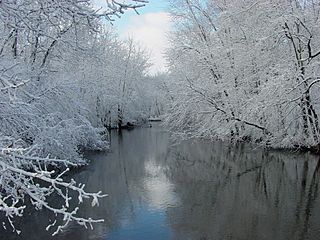Paw Paw River facts for kids
Quick facts for kids Paw Paw River |
|
|---|---|

The Paw Paw River after a snowfall in Van Buren County, Michigan
|
|
| Country | United States |
| State | Michigan |
| Counties | Van Buren, Berrien |
| Physical characteristics | |
| Main source | Confluence of North Branch Paw Paw River and South Branch Paw Paw River North of Paw Paw 686 ft (209 m) 42°15′52″N 085°55′35″W / 42.26444°N 85.92639°W |
| River mouth | St. Joseph River Benton Harbor 581 ft (177 m) 42°06′45″N 086°28′15″W / 42.11250°N 86.47083°W |
| Length | 61.8 miles (99.5 km) |
| Basin features | |
| Tributaries |
|
The Paw Paw River is a river in Michigan, a state in the United States. You can find it in the southwest part of Michigan's lower half. It starts when two smaller rivers, the North Branch and South Branch, join together in Van Buren County, Michigan.
The river flows for about 61.8 miles (almost 100 kilometers) through Van Buren County, Michigan and Berrien County, Michigan. It eventually joins the St. Joseph River near Benton Harbor, Michigan. From there, its waters flow into Lake Michigan.
Contents
River History: How Paw Paw Got Its Name
Native Americans gave the Paw Paw River its name. They named it after the paw paw fruit. This fruit grew in large amounts along the river's edges.
Wildlife and Nature: Animals of the Paw Paw River
The area around the Paw Paw River is very special. It has unique marshes and forests that are home to many animals. These places are important for birds that travel long distances.
Rare Animals Living Near the River
- The prothonotary warbler, also known as the golden swamp warbler, is a colorful bird found here.
- The Mitchell's satyr butterfly, which is an endangered species, also lives in this area.
- Other rare animals include the massasauga rattlesnake and the spotted turtle.
Protecting the Paw Paw River's Nature
People are working to protect the river's natural areas. In 2003, a group called The Nature Conservancy bought 139 acres (about 0.6 square kilometers) of land. This land is part of the Paw Paw Prairie Fen, a special type of wetland.
The Sarett Nature Center also owns a large area of 800 acres (3.2 square kilometers) along the river. This land is in Berrien County and helps protect the river's environment.
Fish Species in the Paw Paw River
The Paw Paw River is home to 39 different kinds of fish. Some common fish you might find include walleye, bass, bluegill, black crappie, and northern pike. The main part of the river is cool, which is good for fish like burbot and mottled sculpin.
Near where the river meets Lake Michigan, you can find steelhead trout. These fish are put into the river to help their population grow. Many types of trout and salmon can swim far up the river system. People often fish for them in the fall, especially upstream of Hartford.
There are 24 small dams in the Paw Paw River area. However, these dams are low or on small streams. This means that trout and salmon can still swim past them to reach the river's upper parts.
Paw Paw River Watershed: Where the Water Comes From
The Paw Paw River's watershed is the entire area of land where water drains into the river. This watershed covers about 445 square miles (1,150 square kilometers). Most of it is in Van Buren County, but a small part is in Kalamazoo County.
Main Branch Tributaries
Many smaller streams and drains flow into the main Paw Paw River. These are called tributaries.
- Sand Creek and Blue Creek flow in near Benton Township.
- Ryno Drain joins the river in Coloma.
- Mill Creek flows in near Watervliet.
- Paw Paw Lake and Little Paw Paw Lake, located in Berrien County, also connect near Watervliet.
- Pine Creek joins the river between Hartford and Watervliet.
- Mud Lake Drain is another tributary between Hartford and Watervliet.
- Hog Creek flows in near Hartford.
- Brush Creek joins the river near Lawrence.
- Carter Creek flows in between Paw Paw and Lawrence.
North Branch Tributaries
The North Branch of the Paw Paw River also has its own tributaries:
- Brandywine Creek
- Hayden Creek
- Ritter Creek
- Todd Drain
- Campbell Creek
The water for the North Branch starts from springs near the Wolf Lake State Fish Hatchery.
South Branch Tributaries
The South Branch of the Paw Paw River has several tributaries as well:
- The East Branch is about 8.5 miles (14 kilometers) long. It starts from Paw Paw Lake in Kalamazoo County and Mattawan Creek in Mattawan. It joins the South Branch in the city of Paw Paw.
- Three Mile Lake Drain, located south of Paw Paw.
- Eagle Lake Drain, also south of Paw Paw.
- Lawton Drain, found east of Lawton.
The South Branch's water begins in Decatur Township in eastern Van Buren County.

